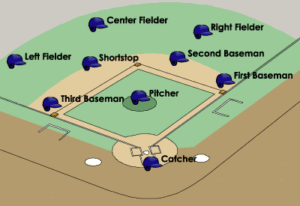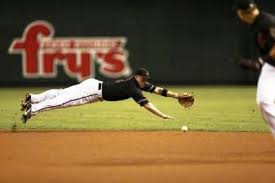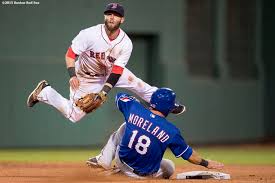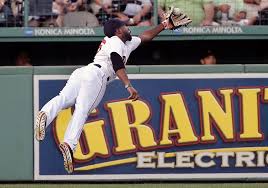The job of the fielders is to get the ball and return it to wherever it will do the most good. Usually this means, wherever there is an offense player that can be “put out” with the ball. Simple in concept, difficult in execution.

First, we will do a review of the defensive players, the fielders.
First, the pitcher. The pitcher is the “point man” of the defense, the player that puts the ball into play by throwing it near the batter. We will cover the subject of pitching separately; here, we will treat the pitcher as “just another infielder”, which of course he is!
The pitcher is at a disadvantage when it comes to fielding. First, he is awfully close to where a batted ball will come from! There is very little time to react. Second, after delivering a pitch, he is off-balance, and has to readjust to the mechanics of fielding. 1. Nevertheless, there are a few situations where the pitcher is indispensable as a fielder. One is the bunt. This is when the batter holds the bat loosely, horizontally, and lets ball hit bat. The result is a slowly-hit ball; the hope for the batter is that this gives a baserunner at first the time to reach second, even if he himself is thrown out at first (a sacrifice bunt). Depending on where the ball actually goes, it will be fielded by the pitcher, the catcher, or the first or third basemen. The other situation is a ground ball that the first baseman fields; in this case, the pitcher runs to first base, gets there before the batter, and receives the throw from the first baseman. Usually, a pitcher will not be able to field a ground ball “up the middle”; he simply does not have time to react!
The catcher is the anchor of the defense. Besides catching all pitches, and calling pitches (again, will be covered under “pitching”), the catcher is responsible for tagging runners out at home (a risky occupation!), catching popups behind or near the plate, fielding slow hit balls such as the bunt, throwing out runners at first (or even picking them off at any base!), and throwing out base-stealers. Catchers are not expected to be great hitters, as their job is hard on the body, and their catching skills are paramount. 2
First base is generally considered to be the “easiest” defensive position, in that it doesn’t require exceptional speed or quickness. Nevertheless, it is anything but easy! He must be a good fielder of ground balls (though he has less territory to cover than the other infielders) and must be able to “scoop” a low-thrown ball from the other infielders, to make a put-out at first. First basemen, because of the lesser defensive demand of their position, are expected to be excellent hitters, and since large size is not a disadvantage at first, to be power hitters. They are typically left-handed fielders, since this has them facing the action when waiting for a throw.
Second basemen are usually the quickest and smallest players on the team. They cover a wide amount of infield (and even more when there is a runner at first, as noted earlier), and so need instantaneous reflexes; they also (as is the shortstop, depending on where the ball was hit) are the “pivot” of the double play, but the second baseman’s role is riskier. We will get back to this.
The shortstop needs the same reflexes and quickness of the second baseman, but can afford to be a bit bigger; again, we will cover this under the “double play”. The second baseman and shortstop are often referred to as the “middle infielders” (as opposed to the first and third basemen, the “corner infielders”); as with the catcher, some offensive deficiency is tolerated (but not too much!)
The third baseman should have almost the quickness of a shortstop, but has less infield to cover, so can be a slower (and bigger) player. Thus, no surprise that third basemen are expected to be power hitters.
The left and right fielders, the “corner outfielders”, have the same job description: catching fly balls, getting to ones they can’t catch and getting the ball back to the diamond, and backing up the infield.
The center fielder has the same job as the corner outfielders, but has a larger territory 3 and thus is usually the fastest and most proficient of the outfielders. All outfielders are expected to be good hitters, often powerful.
 Laying out to snare a grounder.
Laying out to snare a grounder.
The ground ball
This will usually be the province of the infielders (except when it gets between them). If the ball is hit slowly, they will “charge” the ball, to get to it quickly, and then they will throw the ball to whomever is covering the base where the “lead runner” is going (unless no putout is possible, for example if the runner will get there first), but most putouts are at first base.
 Dustin Pedroia completes a double play relay, avoiding the takeout slide.
Dustin Pedroia completes a double play relay, avoiding the takeout slide.
The double play
If there is a runner at first, and a ground ball is hit, the throw will go to second (where, since the runner at first is forced to second, the infielder covering second need only, briefly, touch the base), and then the ball will be thrown to first to get the batter out as well: a double play! Note: if the ground ball is hit to the shortstop, the second baseman will cover second; if the second baseman is the one to field the ball, the shortstop will cover second. Remember I said that the second baseman has a risky job? The runner coming from first to second will slide into second base, attempting to disrupt the second baseman’s throw, or even knock him down! This is riskier for the second baseman than for the shortstop, because the shortstop, if covering second, will have momentum that will carry him past the base after touching it, whereas the second baseman, if covering, will need to stop and turn 180 degrees to make his throw, leaving him in the “danger zone” for a takeout slide.
The triple play
Very rare. Obviously, there needs to be at least two men on base, and no outs. A triple play can be done as an extension of a double play, ie ground ball to third baseman, touches third, throws to second, who throws to first…but this is not the typical triple play; even a slow batter will probably have time to get to first safely. The typical triple play happens with a line drive that is caught by an infielder. If the runners are running, and a line drive is caught, they both need to return to their bases, and will have little time to do so…sitting ducks! Then there is the unassisted triple play, where one infielder gets all three guys out! Scenario: line drive to shortstop, caught (batter is now out). Runners were running, so shortstop quickly touches second base (runner that started at second is out, since he didn’t get back to his base), and directly tags the runner that started at first (who hasn’t had time to stop, turn around and run back…so he is out too!) Watch Rockies shortstop Troy Tulowitzki pull off the play!
 Red Sox center fielder Jackie Bradley Jr. prevents a home run.
Red Sox center fielder Jackie Bradley Jr. prevents a home run.
The fly ball
The outfielders will try to catch this. If there are runners on base, and they started running, he will try to throw the ball back to the infield in time to “double up” the runner…as explained under baserunning. The outfielder will also try to throw a runner out at the plate if he is trying to score…some of the most exciting plays in baseball! Watch this throw by Yoenis Cespedes!
The pop-up
Usually a pretty certain out. Back in the day, however, with men on base, the infielder would sometimes let the ball drop, then throwing the baserunners out (because they did not dare to run, being certain that the ball would be caught!) So nowadays, a popup to the infield with less than 2 outs, and at least 2 men on base, is an automatic out…the “infield fly rule”. Prevents those shenanigans!
Backing up
All fielders are expected to “back up” the other fielders, to be there to catch an errant throw, or a missed catch. Much as I, as a Bostonian, hate to give any New York Yankee credit, watch this play by Yankees shortstop Derek Jeter, who is backing up a play that is a hundred feet from his actual position! Or this lightning-fast flip from Red Sox second baseman Dustin Pedroia! It’s these types of plays that separate great players from good ones.
Yes, home runs are exciting, but to me, great fielding is the best part of a baseball game.
- The greatest dread for a pitcher is the “comebacker”, a hard-hit line drive directly at him. Pitchers have been hurt, some seriously, by comebackers.
- They are not permitted to be black holes in the offense, like NL pitchers, however! They are expected to contribute offensively.
- Usually; for example, Fenway Park has a huge right field (and a small left field), so the right fielder needs the same speed as a center fielder.
